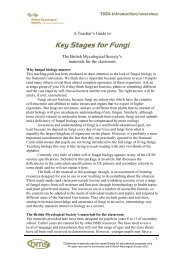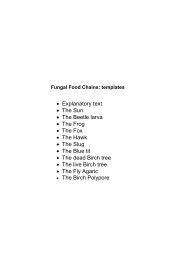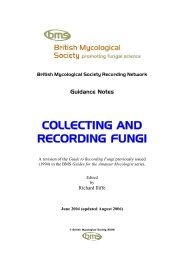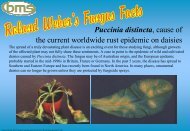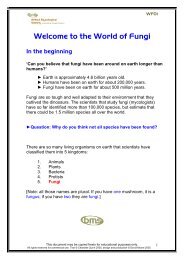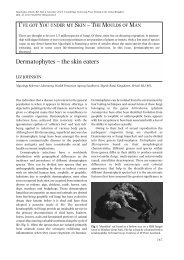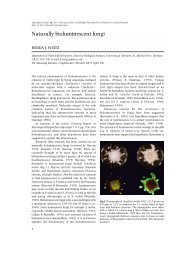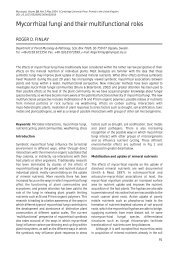Create successful ePaper yourself
Turn your PDF publications into a flip-book with our unique Google optimized e-Paper software.
THE GOOD, THE BAD<br />
AND THE FUNGI<br />
APPENDIX 14<br />
CLASSROOM WORKSHEET<br />
UNDERSTANDING FUNGI /<br />
UNDERSTANDING FUNGI IN<br />
THE FOREST
<strong>Appendix</strong> 14 page 1 of 3<br />
Join the descriptions to the fungus by drawing<br />
a line between them.<br />
The line for the cap has been done for you.<br />
Complete the sentences.<br />
The cap □<br />
The cap supports and protects the _____<br />
or _____ which are where the spores are<br />
produced.<br />
Ring<br />
A partial veil grows from the edge of the<br />
cap to the stem, the ring is what is left on<br />
the ______ as the cap grows and breaks<br />
the ______.<br />
The veil provided extra protection for the<br />
spores when the toadstool was young.<br />
Stem or stipe<br />
The stem or stipe has to hold up the<br />
______ So that when the spores drop<br />
down they are high enough off the ______<br />
to drift away.<br />
Mycelium<br />
The mycelium is the hidden ‘body’ of the<br />
fungus. It finds ______ for the fungus and<br />
when conditions are suitable it is able to<br />
produce a _________.<br />
Understanding Fungi<br />
□<br />
□<br />
□<br />
□<br />
Name:…………………………………<br />
Class:…………………………………<br />
School:……………………................<br />
□<br />
Gills<br />
Gills or pores grow under the<br />
cap and produce ______.<br />
To produce, protect and scatter<br />
the spores is why the toadstool<br />
grows.<br />
The volva<br />
If the fungus has a universal veil, the volva<br />
is what is left of the veil at the bottom of<br />
the stem when the veil is broken.<br />
The veil is broken as the toadstool ______.<br />
This veil sometimes leaves _____ on the<br />
cap as well.<br />
How many differences can you think of between a fungus<br />
and a flowering plant? Write some down here:<br />
Original © Aberdeen Environmental Education Centre 2002. This version produced by David Moore 2006. Illustrations by Kath Hamper
<strong>Appendix</strong> 14 page 2 of 3<br />
Join the descriptions to the fungus by drawing<br />
a line between them.<br />
The line for the cap has been done for you.<br />
Complete the sentences.<br />
The cap □<br />
gills<br />
The cap supports and protects the _____<br />
or pores _____ which are where the spores<br />
are produced.<br />
Ring<br />
A partial veil grows from the edge of the<br />
cap to the stem, the ring is what is left on<br />
the stem ______ as the cap grows and breaks<br />
the ______. veil<br />
The veil provided extra protection for the<br />
spores when the toadstool was young.<br />
Stem or stipe<br />
The stem or stipe has to hold up the<br />
______ cap So that when the spores drop down<br />
they are high enough off the ground _______<br />
to drift away.<br />
Mycelium<br />
The mycelium is the hidden ‘body’ of the<br />
fungus. It finds ______ food for the fungus and<br />
when conditions are suitable it is able to<br />
produce a ____________.<br />
toadstool<br />
Understanding Fungi<br />
□<br />
□<br />
□<br />
Original © Aberdeen Environmental Education Centre 2002. This version produced by David Moore 2006. Illustrations by Kath Hamper<br />
□<br />
Name:…………………………………<br />
Class:…………………………………<br />
School:……………………................<br />
□<br />
Gills<br />
Gills or pores grow under the<br />
cap and produce _________. spores<br />
To produce, protect and scatter<br />
the spores is why the toadstool<br />
grows.<br />
The volva<br />
If the fungus has a universal veil, the volva<br />
is what is left of the veil at the bottom of<br />
the stem when the veil is broken.<br />
grows<br />
The veil is broken as the toadstool ______.<br />
This veil sometimes leaves spots _______ on the<br />
cap as well.<br />
How many differences can you think of between a fungus<br />
and a flowering plant? Write some down here:
<strong>Appendix</strong> 14 page 3 of 3<br />
Understanding Fungi in the Forest<br />
Fungi are in the woodland all the time.<br />
Why don’t we see them most of the time?<br />
Name:…………………………………<br />
Class:…………………………………<br />
School:……………………................<br />
There are three ways that woodland fungi get their food.<br />
Can you name them?<br />
When is a parasitic fungus able to infect a<br />
tree?<br />
How do exchanger fungi link<br />
up to their tree?<br />
A parasite can kill a tree. How can the<br />
death of a tree be a good thing in the<br />
forest?<br />
How does the exchanger<br />
fungus help the tree?<br />
What did we use to help us try and<br />
identify some toadstools?<br />
Can you think of two reasons why<br />
recycler fungi are important in the forest?<br />
Autumn is a good time for recycler fungi;<br />
can you think why?<br />
Original © Aberdeen Environmental Education Centre 2002. This version produced by David Moore 2006. Illustrations by Kath Hamper



